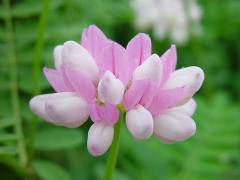Invasive Species: Securigera varia, Crownvetch
Crownvetch is a low-growing, invasive, herbaceous vine that usually forms thickets up to 3 ft. (0.9 m) in height. The leaves are pinnately compound with 9 to 25 pairs of leaflets and a terminal leaflet. Leaflets are 0.75 in. (1.9 cm) long. Flowering occurs in the summer. The fragrant, pea-like flowers are white to pink to purple and resemble a large clover flower. Crownvetch reproduces and spreads rapidly by rhizomes as well as seeds. It forms dense thickets in open, disturbed areas such as fields and roadsides. Once established, it is difficult to remove. Crownvetch is native to Europe, Asia, and Africa. It was first introduced into North America around the 1950s and has been widely planted for erosion control.
What are invasive species and why should we be concerned about them?
Taxonomy: Scientific and Common Names for This Species
Fabales > Fabaceae > Securigera varia (L.) Lassen
Synonym(s): purple crownvetch
Securigera varia – USDA PLANTS Profile
Distribution Maps
Crownvetch – The reported distribution of this invasive species across the United States. (Source: Invasive Plant Atlas of the United States)
Up-to-the-minute distribution maps and why they are important
Reporting This Invasive Species
What is the best way and place to report the occurrence of an invasive species?
How to report an invasive species sighting to EDDMapS – Early Detection & Distribution Mapping System
EDDMapS – Report an invasive species to EDDMapS
Cooperative Extension Offices – Find your local Cooperative Extension office on this map provided by USDA
How to Identify
This invasive species can be identified by looking for the characteristics described in the paragraphs that follow.
Plant
A low-growing, herbaceous vine that usually forms thickets up to 3 ft. (0.9 m) in height.
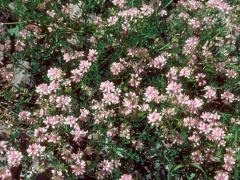 |
 |
| Dave Powell, USDA Forest Service, bugwood.org | Steve Baskauf, Vanderbilt University Dept. of Biological Sciences, bugwood.org |
Foliage
The leaves are pinnately compound with 9 to 25 pairs of leaflets and a terminal leaflet. Leaflets are 0.75 in. (1.9 cm) long.
 |
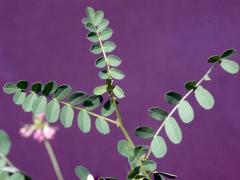 |
| James H. Miller, USDA Forest Service, bugwood.org | Ohio State Weed Lab Archive, The Ohio State University, bugwood.org |
Flower
Flowering occurs in the summer. The fragrant, pea-like flowers are white to pink to purple and resemble a large clover flower.
|
|
|
| Dan Tenaglia, Missouriplants.com, bugwood.org |
Fruit
Crownvetch reproduces and spreads rapidly by rhizomes as well as seeds.
 |
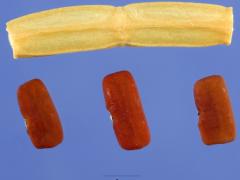 |
| Ohio State Weed Lab Archive, The Ohio State University, bugwood.org | Steve Hurst, USDA NRCS PLANTS Database, bugwood.org |
Native Species That Resemble Crownvetch
Astragalus parryi, Parry’s milkvetch, Bugwood.org
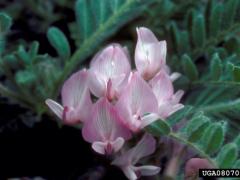 |
 |
| Dave Powell, USDA Forest Service, bugwood.org | Dave Powell, USDA Forest Service, bugwood.org |
Hedysarum boreale, boreal sweetvetch, Bugwood.org
 |
 |
| Mary Ellen (Mel) Harte, bugwood.org | Mary Ellen (Mel) Harte, bugwood.org |
Additional Images for Crownvetch
Crownvetch – Images at Invasive.org
Learning Resources for Crownvetch
Additional Information, Biology, Control and Management Resources
Control and management recommendations vary according to individual circumstances. Location, habitat, weather, and a variety of other conditions are factors that help determine the best treatment choice. To find the safest and most effective treatment for your situation, consult your state’s land-grant institution. If you will use chemicals as part of the control process, always refer to the product label.
United States Land-Grant University System – Find your land-grant university’s College of Agriculture, Cooperative Extension Service, or other related partner on this map provided by USDA.
A Management Guide for Invasive Plants in Southern Forests – USDA Forest Service
A Field Guide for the Identification of Invasive Plants in Southern Forests – USDA Forest Service
Southeast Exotic Pest Plant Council Invasive Plant Manual – SE-EPPC
Element Stewardship Abstract – The Nature Conservancy
Weed of the Week – USDA Forest Service

